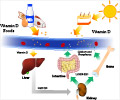Researchers have found that teenage girls living in temperate countries or colder regions of the world would benefit later in life if they took
Researchers have found that teenage girls living in temperate countries or colder regions of the world would benefit later in life if they took supplements of Vitamin D in the winter months when the sunlight exposure to their body is low. The sun is important for formation of the active component of Vitamin D in the body.
The vitamin supplement would help to strengthen bones for later years. The researchers concluded in a study that girls who took supplements during the winter had no decrease in vitamin D status during this time and actually improved their bone mineral levels in the femur. It is known that after the age of 50 years, one in three women and one in 12 men may suffer from osteoporotic fracture of bones such as the hip, wrist or spine.Yet although it is well documented that vitamin D decreases the incidence of fractures in the elderly, this is one of the first studies to investigate vitamin D’s performance in bone accumulation during adolescence. However bone growth during puberty may be important in preventing osteoporosis and fractures later in life.
Researcher Dr Heli Viljakainen said at the second joint www.ects-ibms-2005.org.meeting of the European Calcified Tissue Society and the International Bone and Mineral Society “We believe the current recommendation for adequate vitamin D intake for this age group currently is too low and adolescent girls must receive 10-15 micrograms/day, atleast in the northern latitudes.To maintain optimal vitamin D status gained during the summer supplementation should begin in autumn to maintain sufficient vitamin D in winter months,”
The study looked at 225 girls aged between 11 and 12 who were given a daily dose of 5 micrograms vitamin D3, 10 micrograms of vitamin D3 or a placebo for one year. They also collected other important data like pubertal development, height and weight, physical activity and dietary intake of vitamin D and calcium. The bone mineral density of the lumbar spine and left femur were measured at the beginning and end of the study with dual x-ray absorptiometry.
For study participants who received 10 micrograms/day, no wintertime decrease in vitamin D status was found . Interestingly they found that the bone mineral accumulation in the femur increased in study participants who were receiving 5 micrograms/day by 14.3 per cent. In those who received 10microgm/day supplement the density increased by 17.2 per cent in the 10 microgram/day group. There was no increase found in the placebo group. Similar changes were noted in the lumbar spine.
This study clearly indicates that the current recommendation maybe lower than ideal. The US Food and Nutrition Board at the Institute of Medicine currently recommends 5 micrograms/day as adequate intake for vitamin D. In Finland and other Nordic countries, the current recommended rate is higher at 7.5 micrograms/day., Vitamin D, teenage girls, supplements, sunlight, bone mineral level, osteoporotic fracture, adolescence, puberty, bone growth, Vitamin D3, absorptiometry, calcium, femur, recommended rate











